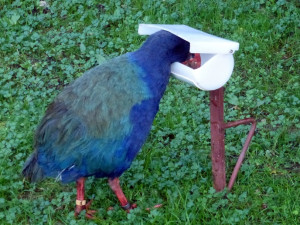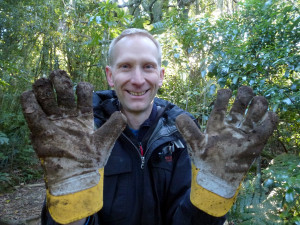Read on to hear about the club’s recent volunteer trip to Kapiti island and further down find out about more opportunities to volunteer (and visit)!
After an early Saturday morning false start, the boat skipper called me about 2:30pm with the news the weather had calmed down enough to take us across late Saturday afternoon. The text alerts went round, and we put our muster plan swiftly into action, all nine of us making it to Paraparaumu Beach by around 4pm.
The skipper was keen to get back before dark so we hurried onto the boat, and any stragglers were given a few beeps of the horn to hurry them up. On the Paraparaumu side the boat is launched by a tractor and the waves were such that those of us in the back of the boat had a bit of a salty encounter. We each sprayed our boots, and any other shoes, with the special biosecurity juice as we were thrown up and down over the waves. Some of us glued our eyes to the horizon and were glad the journey was only ten minutes long!
It’s a beach landing on the island side, and Emma, the DOC ranger (our host and task-master for the weekend) was there to meet us. The skipper instructed us he would back into the beach, and we were all to disembark as quickly as possible by walking the plank off the back of the boat as soon as he gave us the go ahead. Emma escorted us to the Biosecurity shed. Three of us at a time checked through all our belongings very thoroughly in a small sealed room. The room was equipped with various items for capturing and exterminating any biosecurity hazards. As trampers, we are considered high risk, because we’ve all been out in the forests and hills on the mainland collecting all sorts of mud and seeds on our gear. We’d had strict instructions to clean everything, right down to picking out all the bits that get stuck in the Velcro on your gaiters, and the hip pads on your pack. Even so, we managed to prove the on-the-island checks were worthwhile as Kate discovered a stow-away cricket in her lunch! The cricket was appropriately disposed of, and we were all allowed to proceed further onto the island.
 We were staying in the DOC volunteers’ accommodation, called The Red House, which was….erm….a red house. It was also well equipped with lots of luxuries that you don’t normally find in huts on tramping trips like a gas stove and oven, running hot water, a heat pump, a flushing toilet and even a pillow each AND it had great views across the water to the Kapiti coast and the Tararuas.
We were staying in the DOC volunteers’ accommodation, called The Red House, which was….erm….a red house. It was also well equipped with lots of luxuries that you don’t normally find in huts on tramping trips like a gas stove and oven, running hot water, a heat pump, a flushing toilet and even a pillow each AND it had great views across the water to the Kapiti coast and the Tararuas.
Over the next hour we were briefed up to our eyeballs with emergency procedures, health and safety instructions and how to enjoy the birdlife without causing any damage. As we’d been delayed due to the weather, there was unfortunately no time for any work on Saturday, so we felt slightly under-justified tucking into our large portions of cashew noodles designed for re-fuelling after a long day of tramping. To make up for it, and because we were on Kapiti Island, we took a night walk to see what we could see. Several penguins, some weta, and some geckos were spotted (Emma knew they liked to keep warm against the electrics in one of the sheds), but mostly I think ten people trudging along the path at once inevitably makes too much noise to notice much. We heard kiwi, and the weka were also keen to make their presence known. Because we’d now done at least a little bit of exercise we were all completely justified in dipping into the chocolate fondue on the menu for pudding…yumyum.
Not content with the lack of kiwi sightings, and boosted by fondue energy, some of us took a second wander around in the dark. This time I heard a lot more, but still saw nothing, although I spent ages listening to the rustling I was sure was coming my way from the middle of some undergrowth!
Undeterred, in fact maybe spurned on, by the lack of feathered friends most of us were up early for the dawn chorus. I took a cup of tea for a wander round the pathways near the house. I heard rustling from the track above me so loud I thought it must be another of our party also out on their dawn walk…but no…as I stood silently on the track a penguin tum-and-bum-slid through the trees and across the path right in front of me on its way to the beach. He was in a definite hurry – perhaps he had slept through his alarm! The sound of the birds as the day started to dawn was amazing, all sorts of tweets, chirps, squawks, trills and coos really makes you realise what’s been lost from the mainland.
At 8am we gathered our tools (gloves, rakes, spanners, trowels and hoes) and listened as Emma explained how we were going to be helping out clearing the drains alongside and across the Wilkinson Track which is the main track visitors to the island take to the summit trig.
After feeding the resident takahe (not often you get to hang out with such a cool endangered bird!), we headed to the bottom of the track to start work. Four of the group took spanners and trowels to form team “cross-drain”; the top panels of these drains had to be unscrewed before they could be cleared. The remaining five of us were either scrapers or scoopers for the drainage channels running parallel with the track. We worked our way up the track, clearing all the rotting leaves, stones and soil out of the drains as we went, and carefully throwing the contents on the down side of the track.
Morning tea-time found us at the hihi feeders, conveniently located next to a picnic bench. There were a few hihi coming and going, and also two kaka performing their latest dance routine for the gathering scouts who were visiting the island for the day. After some timely jet-planes, a couple of scrapers and scoopers headed back down the track to relieve team “cross-drain” who were making slower progress up the track due to the fiddly spanner aspect of their task. We had a quick re-think and re-designed the work-flow to make the process more efficient.
For future reference, the fastest system seemed to be having a pair of ‘spanners’ walking up the track  undoing all the bolts, followed by a pair of ‘lifters and scrapers’ removing the wooden drain covers, cleaning out the gunk, then replacing the covers. The ‘spanners’ would undo five drains, then turn back down to tighten up the covers on the first one when the ‘lifters and scrapers’ had finished. I think some of us probably walked the length of the track four or five times loosening and tightening the bolts on those drains!
undoing all the bolts, followed by a pair of ‘lifters and scrapers’ removing the wooden drain covers, cleaning out the gunk, then replacing the covers. The ‘spanners’ would undo five drains, then turn back down to tighten up the covers on the first one when the ‘lifters and scrapers’ had finished. I think some of us probably walked the length of the track four or five times loosening and tightening the bolts on those drains!
We finished the morning near the top of the track, and walked on to the summit for lunch. Along the way we heard a kokako! From the summit we had fantastic views across the Cook Strait to the South Island, and we ticked saddleback off the list of bird species spotted. After lunch we managed to clear another section of the track before walking the rest of the way down in time to catch the ferry back at 3pm.
I tried my best to leave DOC with some permanent volunteers by ‘forgetting’ to tell some of the group that the boat would be picking us up from the north beach, rather than the south one on which we had been dropped off. Fortunately for them the skipper waited until we had everyone on board before shuttling us safely back to reality.
 More volunteering opportunities:
More volunteering opportunities:
Volunteering on Kapiti is a great way to get out on the island, and have the opportunity to stay overnight. DOC are keen to have WTMC back as many hands make light work when it comes to looking after this special reserve. There are two dates on the Spring/Summer schedule – 29th/30th November and 24th/25th January as a back-up as the weather often hampers the ferry trip. These trips need a leader/organiser (no navigation required!) so if you are interested then catch me (Emily) or Debbie at a club night or email the .
DOC have also invited club members to become “hihi heroes” on Kapiti Island. Sugar water is provided throughout the year at several locations around Rangatira (these are the feeders mentioned in my trip report). DOC are looking for willing volunteers who can get themselves to the Kapiti boat club for around 8.30am Saturday morning for an overnight stay, 3 or 4 times per year. Volunteers carry sugar water to the feeders and also help out with other hihi related duties, like the clean-up and regular maintenance of hihi equipment. It is a lovely way to spend time on the island while contributing to the core work carried out on the island. Transfers by boat would be covered, but you’d need to bring your own food. If anyone is interested then catch me (Emily) at a club night or email for more info!



